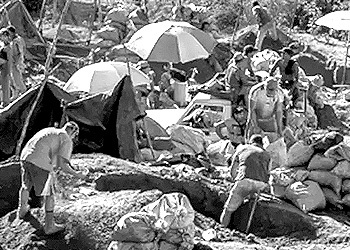Tren de Guayana is one of the most powerful mining gangs known as sindicatos that jockey to control gold mines in the southern Venezuelan state of Bolívar. Despite bloody conflicts with rival gangs and state forces, for over a decade, the sindicato has managed to hold on to key territories where it can control and profit from small-scale miners’ activities and the illegal gold trade.
History
Tren de Guayana began operating as an urban gang in the Vista al Sol neighborhood of San Félix, the old town of Ciudad Guayana, around 2007. The group was initially led by Yorman Pedro Márquez Rodríguez, alias “El Gordo Bayón.” Under his leadership, the gang gained notoriety throughout San Félix and began taking control of mining zones in the Roscio municipality, which lies to the city’s southeast.
Bolívar state authorities allegedly sponsored Tren de Guayana’s expansion into mining zones. Two former security officials turned whistleblowers claimed the gang enjoyed political patronage from officials, including then-Governor of Bolívar Francisco Rangel Gómez and his secretary of public security, Julio César Fuentes Manzulli.
In June 2014, Gordo Bayón was assassinated, reportedly by gang leader Eduardo Natera, alias “El Pelón Natera” or “Run,” who now leads rival sindicato, the R Organization (Organización R – OR). Leadership passed smoothly to Vladimir Sanclemente Ojedo, alias “El Capitán,” and Tren de Guayana continued to expand, taking control over mining territories in the Sifontes and El Callao municipalities.
But starting in 2017, Tren de Guayana began to lose ground. Whatever political protection the group had once enjoyed was withdrawn. It was targeted in a significant anti-gang crackdown, which forced the sindicato out of some of the mines it controlled in Sifontes. Then, in June 2018, El Capitán was included on a list of high-priority targets when the government launched Operation Metal Hands (Operación Manos de Metal), a campaign to crack down on mining gangs and control the gold trade. He was killed in a confrontation with security forces just four months later.
Ronny Colome Cruz Yackson, alias “Ronny Matón,” then took charge, making a violent name for the sindicato as he fought to maintain its control over gold mines. The OR once again threatened Tren de Guayana in 2021 when it launched a violent campaign to take over mines in El Callao and Roscio. The two groups brokered a truce later that year, but the region remains volatile.
Criminal Activities
Tren de Guayana likely receives most of its income from its activities in Bolívar’s gold mines, although there is little evidence that gang members mine the gold themselves. Instead, sources in mines under Tren de Guayana’s control say, the gang extorts local miners and, in some cases, demands a cut of the gold and gold ore produced. The group has also long extorted local vendors in the markets of San Félix.
Leadership
Ronny Matón has led Tren de Guayana since 2018. Press reports link Ronny Matón with the gang’s original leaders as early as 2012, making him a natural successor. Under his leadership, the gang has fought to maintain operations in both urban and mining areas, with trusted “lieutenants” overseeing the gang’s activities in different territories.
Geography
Tren de Guayana maintains a permanent presence in both urban neighborhoods and rural mining zones in Bolívar. In the Caroní municipality, the group has fought to maintain its control over San Félix’s markets and still has a presence in the Vista al Sol neighborhood, where the gang originated.
The group’s expansion into the illegal mining sectors of the Roscio and El Callao municipalities accounts for much of their income. Tren de Guayana is the dominant actor in Roscio’s sector of Guasipati, especially the Cicapra and Vainitas mines. The group is also reported to maintain a presence in some of El Callao’s mines, but the extent of their control remains unclear as state forces and rival criminal groups dispute the area.
Allies and Enemies
Although the political clout of Tren de Guayana appears to have diminished since the end of Rangel Gómez’s governorship, multiple sources that spoke to InSight Crime and press reports suggest that the group works closely with corrupt sectors of the military and security forces, claims that have been repeated by the group’s rivals. These connections, however, appear to be alliances of convenience that are liable to break down. In late 2022, the security deployment Operation Roraima targeted the gang in both El Callao and Roscio.
However, Tren de Guayana does not appear to have any significant criminal allies, clashing with other gangs that operate in or near its territories.
Tren de Guayana’s rivalry with Run and the R Organization stretches back years and only seems to have intensified as both Run and Tren de Guayana have expanded into mining territories. Despite the truce that ended the two groups’ latest round of fighting, shortly after the agreement was struck, a member of the OR told InSight Crime that the two groups remain enemies.
The gang has also had a long-running conflict over mines in El Callao with the Sindicato of El Perú since at least 2014. Tensions flared up in 2017 and 2019, and again in early 2022.
Prospects
Tren de Guayana’s territorial control has fluctuated greatly since its early days. Although it has declined since the peak of its powers prior to the security forces operations of 2017, it is still considered one of the strongest mining gangs in Bolívar. Previously its alleged alliances with security forces have helped it weather attacks by rivals. Still, security operations targeting the group in late 2022 suggest it may no longer be able to count on this support, leaving the group more vulnerable than before.

